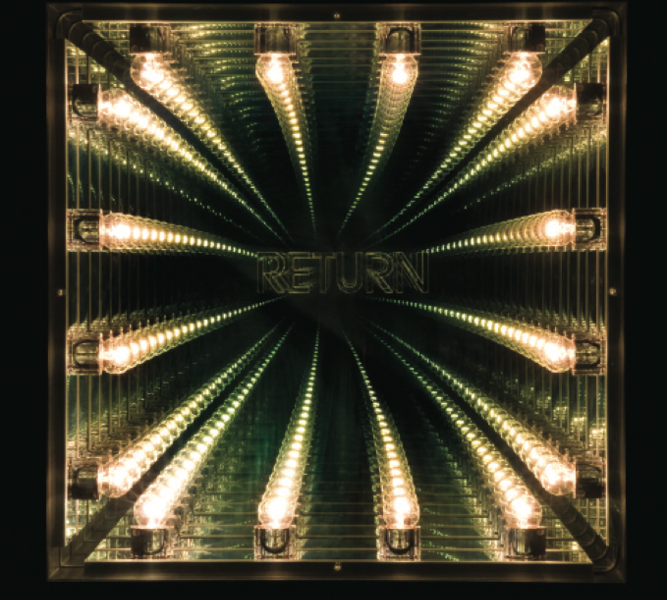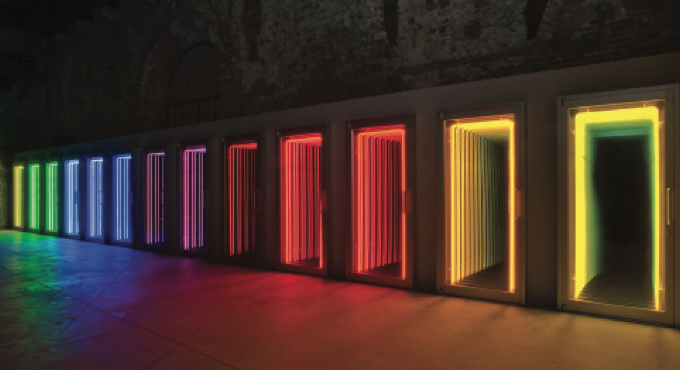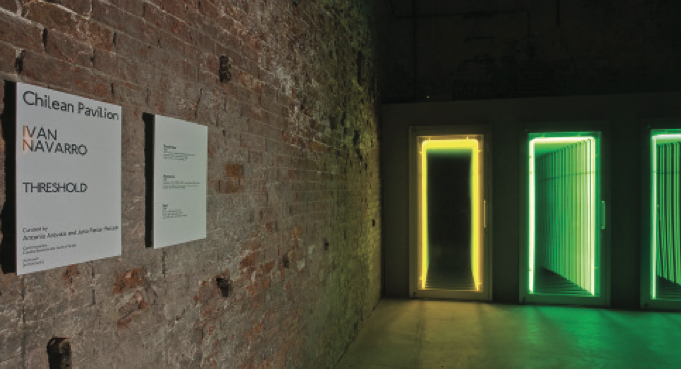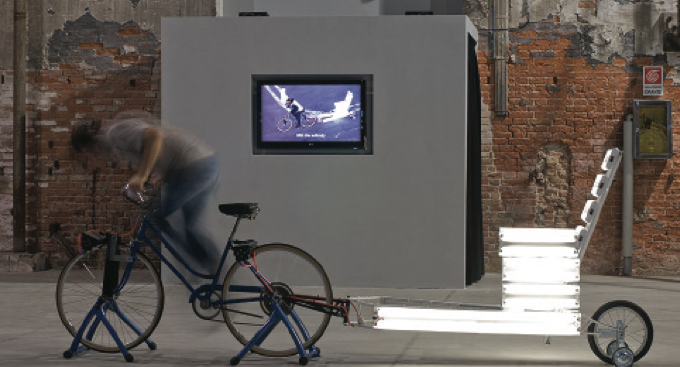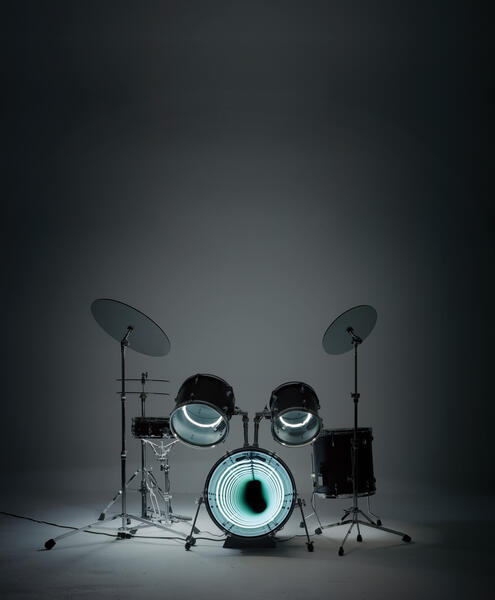Iván Navarro
“We do not need any flags”
Iván Navarro (b. Santiago de Chile, 1972, based in New York) belongs to the generation of Latin American artists who, as of the 1990s, have reelaborated the relationships between modernism and contemporaneity, using as their point of departure the experiences of the most purist avant-garde movements within Modern art, ranging from geometric abstraction through constructivism and concrete art, finally to reach minimalism, Op Art and their more contemporary derivatives.

His work originates in a singular inquiry into the potentialities of energy; it includes the elaboration of light constructions and resorts to conversion principles. They are functional sculptures, objects with a strong visual impact and structural complexity. Among his best-known works are the Electric Chairs, made of fluorescent tubes; objects of impressive design whose fragility and high voltage undermine the seductive qualities of ergonomic perfection: the electric chair, still used in some places in the United States as an instrument of death, or as a torture machine during the military dictatorship in Chile, a period that Navarro had to live through during his formative years. In this respect, his brother, Mario Navarro comments, “Like many people who lived in Chile during that period, he witnessed many violent deeds that suppressed individual freedom in his everyday life, as for example, the prolonged periods of curfew; the police shoot-outs outside his house that forced him to throw himself to the floor in his bedroom, or having to get used to his family listening in the dark to a battery-operated radio always tuned in to the same news program when the towers that supplied electricity to the city were bombed. No doubt these incidents created in his mind an unconscious basis that somehow associated electricity, the media, and violence” 1.
Navarro’s art reflects and revolves around critical appropriations from US minimalism, transcending its pure formalism by addressing political and social issues with an underlying criticism of power and authority. He plays with immediate references to modern formalism, transforming − as the alchemist he actually is − simple materials into radiant forms, extracting them from conventionalism.
On the one hand, he uses the energy possibilities necessary to construct his countless industrial and domestic machines, and on the other, he reminds us of the notion of power that characterizes them, linking them to the use assigned to them in contemporary society and as political metaphor for the circulation of knowledge. Chile has just presented Navarro as its representative to the 53rd Venice Biennial. It is significant that the country should be represented on this occasion by an artist such as Navarro, who belongs to a generation of artists born and raised under a dictatorial regime, and who, with this experience as their point of departure, are beginning to configure their own artistic modus operandus.
In Venice, the scene opened as if trying to transcend that reality through an optical illusion. The project, specifically devised for the 53rd edition of the biennial and entitled “Umbral” (Threshold), was comprised of three works: Death Row (2006), the video Resistance, and Bed, a circular sculpture that gives the impression of being a deep hole (Neon light, plywood, and electric energy). “The three pieces speak more of the idea of exile than of the dictatorship; perhaps there were references to things that occurred during the dictatorship, but they are more related to the life experiences of the immigrant − as in my case, in New York − as well as of those people who have no possibility of returning to their countries. It alludes to the contemporary situation of being in some place in between. It doesn’t have recourse to local history and refers more to the idea of a state of transition”.2
Death Row is inspired by Ellsworth Kelly’s work, Spectrum V (1969); in the words of Anne Ellegood, “Navarro’s use of Kelly does not faithfully reenact the work in its orinigal medium...”. He has drawn upon the sculptural practices of an important group of artists, among whom Dan Flavin is particularly noteworthy. “His interest in this work has more to do with locating himself within the history of American art -after having chosen to live in New York City beginning in 1997- and a desire to integrate the concerns and subjets of his homeland within the specific histories and movements of American Art”.3
“Doors are standard, relatively cheap objects; they are bought to be installed in a couple of hours in many buildings in the city. The mirror in front of each door is a glass mirror. In this case, the viewer is the guardian of the space, since he is able to see through the light tunnel...like a surveillance”.4
A magical door with the depth of a metaphor. Doors represent the passage between two states, between two worlds, between the known and the unknown, light and darkness, wealth and misery. Doors always open onto a mystery, a journey into the beyond. Doors are means of entrance or exit. In this case, they only allow the viewer to observe, to remain at the threshold. That is the space. The perception of a luminous abyss proposed as if it were a mental device. A representation of infinity through the play of light and mirrors shows us a provocative manner of perception; through specular fragmentation, the viewer seeks a way of escape or an access way. Language is experienced as in a perpetual state of belligerence, as a conveyor of internal drives that find in the artistic image a place of arrival and departure.
The video Resistance showed an installation displayed in Times Square: here the sculpture featured a chair made of fluorescent tubes tied to a bicycle powered directly by a man/performer who, through his own energy − his pedalling − powered the generator that activated the neon lights. This is a common trait in Navarro’s works, in which we can always see a protagonist (the performer) who, gathering fuel from different sources, parades through the landscape, sometimes in the periphery, and on this occasion in the heart of a city lit by commercial advertisements, thus creating a sharp contrast between the incitement to consume and the energy applied to generate light.
Every work of art, says Iván, is a preconceived fiction which has obviously been addressesd beforehand: in art everything is the representation of something; he is absolutely right, since “art serves to beautifully expose, to mark the strange consistency of things, the quiet solitude in which everyday objects find themselves, tempered by the common normal quality of their functionality”.5
Like those doors6, for example, which are a kind of blank book in which a transversal story is written. A story that, as if to stigmatize, appears before us in this strange and cruel palimpsest that is the life of a country, of its men, and of those who are no longer there but who − through this metaphor − continue to exist. Because everything participates in life.
1 “Declassified document” by Mario Navarro. Catalogue, ““Produciendo realidad, arte y resistencia latinoamericana” (Producing reality: Latin American Art and Resistance). Lucca, June 2004.
2 “Umbral”, Iván Navarro’s interview with Natalia Arcos for ARTV.
3 “Resistance of Flags”, Anne Ellegood, Threshold, 53rd Internacional Art Show, Venice Biennale. Charta.
4 E.mail exchange between Iván Navarro and Justo Pastor Mellado. “Threshold”, Ivan Navarro / Charta) original in Spanish.
5 Achille Bonito Oliva. 6 Death Row, Iván Navarro, 2006.
Profile :
Iván Navarro was born in 1972 in Santiago, Chile, where he grew up under the dictatorship of General Augusto Pinochet. From 1991 to 1995 he studied art at the Universidad Católica de Chile, graduating with a degree in printmaking. In 1997 he moved to New York, where he has lived and worked ever since. For the last 10 years his work has been primarily sculpture based on light. He has exhibited actively throughout Latin America, the United States and Europe in places like The Whitney Museum, New York;
El Museo del Barrio, New York; The Hirshhorn Museum, Washington DC; MOCA, Miami; North Dakota Museum of Art, Grand Forks; SITE Santa Fe, Santa Fe; Witte de With, Rotterdam; Prague Biennale 2, Prague; Galerie Daniel Templon, Paris; Towner, Eastbourne; Distrito Cuatro, Madrid; Adelaide Festival, Adelaide; Museo Nacional de Arte, Lima; Centro Cultural Matucana 100, Santiago; CAB, Burgos. Iván Navarro was also chosen to represent Chile in the 53th Venice Biennale, 2009.

